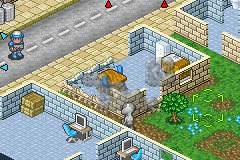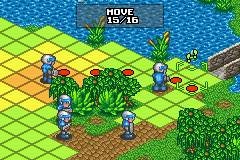For as long as the GBA has existed, fans of the classic PC strategy game X-Com have clamored for a portable version. Better late than never; the makers of the legendary tactical game have finally come through with Rebelstar: Tactical Command. Though it lacks the base-building and economic concerns of its ancestor, Rebelstar delivers in a big way with a lengthy, engaging campaign married to an elegant turn-based combat system.
In the game's sci-fi storyline, Earth has been overrun by a psionic race of aliens called Arellians who resemble your standard X-Files extraterrestrials. Under Arellian rule, humans are implanted with mind-reading chips at birth, then taken away from society once they reach 30 years of age. The humans with the willpower to resist the mind-control chips have formed ragtag rebel bands to fight the Arellians, as well as the Zorn, a brutish alien race who serve their Arellian masters. A third alien race, the insect-like Fraylar, also get involved. You'll take the role of a human lad named Jorel, who runs away to join the rebel cause after his parents are abducted. Over the course of the game's lengthy 24-mission campaign, you'll learn more about the relationships between all the races, and more about Jorel as well.

The core of Rebelstar's gameplay is turn-based, tactical combat on a gridlike map. You'll control small squads of soldiers, each of whom can carry weapons like sniper rifles, laser pistols, and even combat knives, as well as other equipment like ammo clips and grenades. Each side takes turns, during which you can move each of your troops, order them to fire, and/or do special actions such as heal a friendly unit or use psionic power to frighten or stun enemies. The game follows strict line-of-sight rules, so you can only see what your soldiers see in front of them. Obstructions on the maps, like foliage, walls, and debris, can not only provide cover, but concealment as well. Some of these obstacles can be destroyed by heavy weapons; you'll need to take full advantage of the terrain in each map to succeed.
Those who are familiar with X-Com will recognize Rebelstar's action-point system, which determines how much each of your soldiers can do in a turn. Everything from moving to firing a weapon, reloading, or throwing grenades takes a specified number of action points. Even the act of turning your character around takes a few points. This forces you to make some hard decisions about where and how far to move your soldiers on a turn, lest you find yourself face-to-face with an enemy, without enough action points to fire your weapon. To help you out with this, the game shows you a handy, color-coded grid each time you select a soldier to move. This shows you how far you can move while still having enough points left to do an aimed shot, or a quicker (but less accurate) snap shot. If you leave yourself enough action points at the end of a turn, you can put your soldier into overwatch mode, which will allow him or her to attack during the enemy's turn if a foe should wander into that soldier's line of sight. Not everything's quite the same as X-Com, though. You can't kneel or go prone to improve your accuracy, for example.
If you're not a fan of turn-based strategy, you may find the control system in Rebelstar: Tactical Command a little overwhelming at first, because you have to keep track of a lot of esoterica like morale, initiative, and facing. But for those of you who grew up with X-Com, you'll find that the signature interface is just as elegant as it was all those years ago, if not even more streamlined. Thankfully, for those of you who may not be as familiar with the interface, the campaign starts off slow, introducing all the different options available to you at a manageable pace and not throwing too many soldiers at you to control at first. As the varied campaign wears on, you'll need to control multiple squads and think carefully about how to equip each of them before you deploy. There's also an RPG-like element in Rebelstar to consider. Each of your troops gains in experience as they kill enemies, letting you improve their weapon proficiency in various categories. Since each of your soldiers has a base personality and proficiency, though, you'll probably find yourself continuing to specialize each of your squad members, instead of making all of them completely well-rounded. The campaign missions themselves are varied and challenging. Whether you're running away from Zorn, trying to escape through a lush jungle, or raiding a Fraylar base, you'll find yourself pondering each move carefully, trying to maximize your combat efficiency.
Once you're done with the campaign, you can play any of the levels in a skirmish mode, choosing from any of the game's four races. Each race has its strengths and weaknesses, with the Arellians specializing in psionic power, and the Zorn, while not so great with weapons, taking a lot of hits before going down. You can even play skirmish games against a friend by swapping the Game Boy back and forth between turns (but no link-mode play is available).

If Rebelstar: Tactical Command falters in any way, it's in presentation. The art style in-game has a charming cartoonlike quality to it, and there are several different tilesets displayed across the maps. But you can't help feeling that the game looks a bit sparser than it should. Between missions, you're treated to some anime-like storyboards where the plot unfolds. While functional, these don't really add as much to the atmosphere as you'd hope. Sound effects in the game are also somewhat muted and weak, and the music isn't particularly memorable.
Despite its shortcomings in presentation, Rebelstar: Tactical Command delivers where it counts--in the gameplay. While not as deep as the designer's previous work, the game offers a compelling and challenging story mode that should keep turn-based strategy fans glued to their GBAs for quite a while.